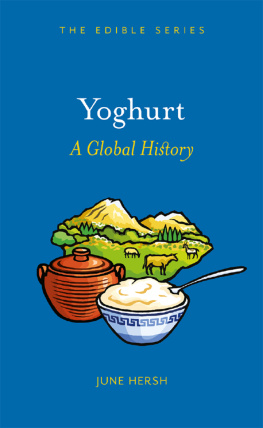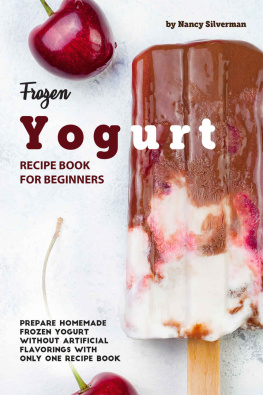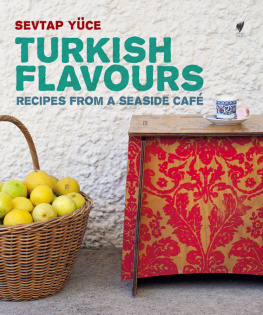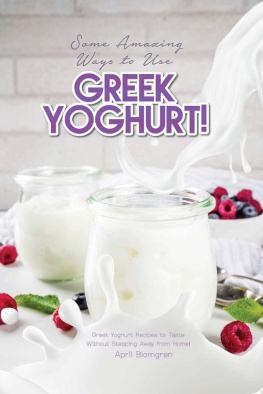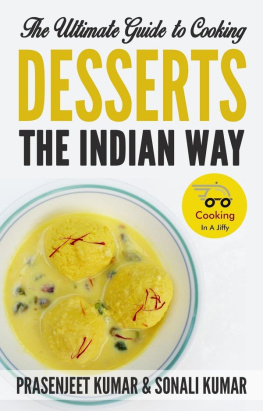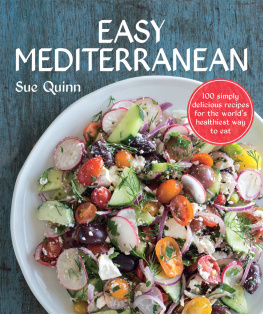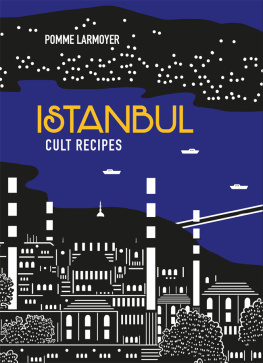YOGHURT

Edible
Series Editor: Andrew F. Smith
EDIBLE is a revolutionary series of books dedicated to food and drink that explores the rich history of cuisine. Each book reveals the global history and culture of one type of food or beverage.
Already published
Apple Erika Janik, Avocado Jeff Miller, Banana Lorna Piatti-Farnell, Barbecue Jonathan Deutsch and Megan J. Elias, Beans Nathalie Rachel Morris, Beef Lorna Piatti-Farnell, Beer Gavin D. Smith, Berries Heather Arndt Anderson, Biscuits and Cookies Anastasia Edwards, Brandy Becky Sue Epstein, Bread William Rubel, Cabbage Meg Muckenhoupt, Cake Nicola Humble, Caviar Nichola Fletcher, Champagne Becky Sue Epstein, Cheese Andrew Dalby, Chillies Heather Arndt Anderson, Chocolate Sarah Moss and Alexander Badenoch, Cocktails Joseph M. Carlin, Coffee Jonathan Morris, Corn Michael Owen Jones, Curry Colleen Taylor Sen, Dates Nawal Nasrallah, Doughnut Heather Delancey Hunwick, Dumplings Barbara Gallani, Edible Flowers Constance L. Kirker and Mary Newman, Eggs Diane Toops, Fats Michelle Phillipov, Figs David C. Sutton, Foie Gras Norman Kolpas, Game Paula Young Lee, Gin Lesley Jacobs Solmonson, Hamburger Andrew F. Smith, Herbs Gary Allen, Herring Kathy Hunt, Honey Lucy M. Long, Hot Dog Bruce Kraig, Ice Cream Laura B. Weiss, Jam, Jelly and Marmalade Sarah B. Hood, Lamb Brian Yarvin, Lemon Toby Sonneman, Lobster Elisabeth Townsend, Melon Sylvia Lovegren, Milk Hannah Velten, Moonshine Kevin R. Kosar, Mushroom Cynthia D. Bertelsen, Mustard Demet Gzey, Nuts Ken Albala, Offal Nina Edwards, Olive Fabrizia Lanza, Onions and Garlic Martha Jay, Oranges Clarissa Hyman, Oyster Carolyn Tillie, Pancake Ken Albala, Pasta and Noodles Kantha Shelke, Pickles Jan Davison, Pie Janet Clarkson, Pineapple Kaori OConnor, Pizza Carol Helstosky, Pomegranate Damien Stone, Pork Katharine M. Rogers, Potato Andrew F. Smith, Pudding Jeri Quinzio, Rice Renee Marton, Rum Richard Foss, Saffron Ramin Ganeshram, Salad Judith Weinraub, Salmon Nicolaas Mink, Sandwich Bee Wilson, Sauces Maryann Tebben, Sausage Gary Allen, Seaweed Kaori OConnor, Shrimp Yvette Florio Lane, Soup Janet Clarkson, Spices Fred Czarra, Sugar Andrew F. Smith, Sweets and Candy Laura Mason, Tea Helen Saberi, Tequila Ian Williams, Tomato Clarissa Hyman, Truffle Zachary Nowak, Vanilla Rosa Abreu-Runkel, Vodka Patricia Herlihy, Water Ian Miller, Whiskey Kevin R. Kosar, Wine Marc Millon, Yoghurt June Hersh
Yoghurt
A Global History
June Hersh
REAKTION BOOKS
Published by Reaktion Books Ltd
Unit 32, Waterside
4448 Wharf Road
London N1 7UX, UK
www.reaktionbooks.co.uk
First published 2021
Copyright June Hersh 2021
All rights reserved
No part of this publication may be reproduced, stored in a retrieval system, or transmitted, in any form or by any means, electronic, mechanical, photocopying, recording or otherwise, without the prior permission of the publishers
Page references in the Photo Acknowledgments and
Index match the printed edition of this book.
Printed and bound in India by Replika Press Pvt. Ltd
A catalogue record for this book is available from the British Library
eISBN 978 1 78914 413 0
Contents

Introduction
Yoghurt: A Food Fad
Trending for Millennia

Few foods can claim to have been consumed as early as 10,000 BCE and to have sustained enough popularity in the thousands of years since to remain a kitchen staple today. Even fewer could be called plain, tart or sour and have those pejorative terms considered to be compliments. However, those statements hold true for one of the worlds oldest fermented foods: yoghurt.
Yoghurt is one of the most pliable and versatile foods, serving not only as an ingredient or condiment, but as a stand-alone meal. It can be eaten at breakfast, lunch or dinner and makes for a healthy snack and delectable dessert. It pairs well with both savoury and sweet add-ins and is enjoyed across the globe with a spoon, a straw or as a frozen confection. It is simple to prepare at home and, for some, making it is a ritual of weekly practice. It has proven health claims that take it from being a super food, which has nutritional benefits, to a functional food with a bonanza of value-added characteristics. Yoghurt is feeding and fuelling populations in every corner of the world with the nutrient-dense benefits of milk, without the side effects suffered by those who are lactose-intolerant.
To better understand the impact of yoghurt, you need to understand its healthy characteristics. As Robert Hutkins explains in his book Microbiology and Technology of Fermented Foods (2006), when a food is fermented, as yoghurt is, its raw materials are converted through the action of microbes. Microbes are what transform grapes into wine or soybeans into tempeh and miso. What makes these fermented foods so valuable are the billions of live microbes, good bacteria that you are ingesting and introducing to your gut. Because these microbes confer a benefit to the host, they are considered probiotic (from the Greek word for life). And while, Hutkins admits, they are often merely visitors, when consumed regularly, they can compete with bad bacteria, produce vitamins and help modulate your immune system.
Yoghurt was a transformative food for Neolithic people and became the foundation of many of the worlds first collective communities. While Neolithic people undoubtedly didnt have the level of sophistication needed to understand the complex process of fermentation, they found that when they ate foods such as yoghurt, they felt better and stronger. It is no surprise, therefore, that yoghurt is mentioned and revered in the ancient religious scripts of almost every world religion, is the subject of exhaustive archaeological findings and can be found in the theoretical writings of classical Greek and Roman scholars.

Curds in a traditional Indian Manipuri pot.
As it proliferated in the diet of many residing in Central Asia, yoghurt became an important ingredient during the Golden Age of Islam, and recipes featuring it were integral to the worlds oldest cookbooks. In the late 1800s and early 1900s, yoghurt became the focus of many scientific studies, and the prescient writings from ancient scientists were being tested and proven in labs throughout the world. When yoghurts health halo was firmly affixed, it was the topic of news stories across the globe, and yoghurt for medicinal purposes was all the rage. The twentieth century saw yoghurt move from a pharmaceutical product to an indispensable member of the supermarket dairy aisle as manufacturers seized on its momentum and ushered in the age of yoghurts commercialization.

